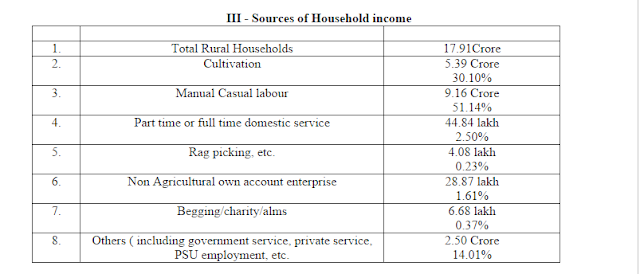Data of Socio Economic and Caste Census (SECC) 2011 for Rural India Released
Hon’ble Finance Minister Shri Arun Jaitley and Hon’ble Minister Rural
Development, Panchayati Raj and Drinking Water Supply and Sanitation,
Shri Chaudhary Birendra Singh, today jointly released on-line the
provisional data from the Socio Economic and Caste Census (SECC) 2011
for Rural India. The Report of the SECC 2011 is available on http://secc.gov.in. The management of the Central data base is with the NIC.
SECC 2011 is a unique paperless Census. The enumeration of the data was
done using over 6.4 lakh electronic handheld device. Household data was
taken from the National Population Register along with the Temporary
Identification Number (TIN). At each stage there was an opportunity for
transparency and grievance redressal.
A total of 1.24 crore claims and
objections were received of which 99.7% have already been resolved. Gram
Panchayats and Gram Sabhas were involved in this process, besides
School Teachers and Data Entry Operators as enumerators. The districts
and State Governments have carried out the SECC with the Ministry of
Rural Development as the nodal Ministry. Ministry of Housing and Urban
Poverty Alleviation carried out the survey in urban areas and the
Registrar General, Census of India carried out the caste census.
The provisional socio-economic data for Rural India has been released.
The survey has been completed in all the 640 districts. It is
provisional as the final lists are being uploaded in some districts
after addressing all the objections received. It is being released as
its use in evidence based planning for rural development and poverty
reduction needs to be undertaken immediately.
It provides very useful
data on households regarding various aspects of their socio-economic
status – housing, land-holding/landlessness, educational status, status
of women, the differently able, occupation, possession of assets, SC/ST
households, incomes, etc. SECC provided for automatic exclusion on the
basis of 14 parameters, automatic inclusion on the basis of 5 parameters
and grading of deprivation on the basis of seven criteria. The data
addresses the multi dimensionality of poverty and provides a unique
opportunity for a convergent, evidence based planning with a Gram
Panchayat as a unit. The data is an opportunity to make evidence based
selection, prioritization and targeting of beneficiaries in different
programmes.
 |
| Data of Socio Economic and Caste Census (SECC) 2011 for Rural India Released |
The household data is also available for planners of programmes at State, district, Block, Gram Panchayat and village level. SECC provides an opportunity to simultaneously address the multi-dimensionality of poverty by addressing the deprivation of households in education, skills, housing, employment, health, nutrition, water, sanitation, social and gender mobilization and entitlement. The use of the NPR TIN Number across programmes affords an opportunity to track the progress of households over the years.
SECC truly makes evidence based targeted household interventions for poverty reduction possible. It paves the way for a Mission Antyodaya to work simultaneously in addressing the poverty of households through a Gram Panchayat Poverty Reduction Plan. The Ministry of Rural Development, in consultation with States, is trying to implement a convergent, integrated poverty reduction plan with Gram Panchayats and deprived households as priority.
Source






